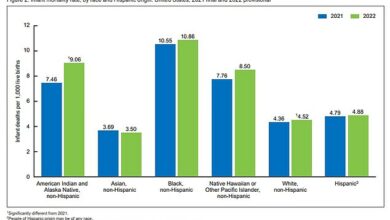DR MAX PEMBERTON: My ten tips to ensure your male GP takes you seriously




I want you to imagine someone having a heart attack. Imagine the scene: they are on the street and suddenly clutch their chests and sink to the ground. They are overweight, may smoke and drink too much and do not take good care of their health.
I bet the person you thought was a man, right? Certainly, most doctors would have thought of it as a man, because cardiovascular disease – a general term for diseases of the heart or blood vessels that can lead to a heart attack – has always been considered a ‘male disease’.
But the reality is that it is the biggest killer of women in Britain. And because we don’t recognize this – because the myth that men suffer from much more heart disease is so persistent – women don’t get good, timely treatment. It’s a silent epidemic.

Cardiovascular disease is the biggest killer of women in Britain
Now 33 cardiologists have spoken out and written a joint statement in the academic journal Heart. These highly gendered attitudes result in thousands of unnecessary deaths among women every year, they say, and demand that the NHS takes action to improve care for women.
Despite affecting 3.6 million women in Britain, cardiovascular disease is ‘underdiagnosed’ [and] undertreated’ in female patients, they argue.
The ignorance they emphasize – to put it charitably – is breathtaking. Women are more likely to have symptoms, such as high blood pressure, that are dismissed by doctors; less likely to receive
life-saving treatment in a timely manner; and less likely to be involved in clinical trials for new drugs.
Shocking studies have also shown that women are less likely to get pain relief than men and have to wait longer before being seen by health professionals.
It was once thought that women’s poor experience in healthcare was the result of old misogyny, but with women now making up a significant portion of the workforce, things are clearly a little more complicated.
Can it really be that stereotypes about women being more vulnerable, making more of a fuss, less able to cope with pain – in short, the ‘hysterical’ woman of the Victorian era – still support the feeling that women are not as serious as men when they ask for help? If so, it is clear that they are wrong.
How can you combat this when you sit in front of your doctor and how do you make sure he or she takes you seriously?
It must be said that it is primarily the responsibility of the medical establishment to make improvements. It shouldn’t be up to women to have to change things.
But we live in the real world, and there are some things women can do to make sure they feel heard.
This is what I recommend…
- Write a timeline. Go to the consultation with a clear overview of your problem day by day. This helps show the doctor that you have been monitoring your symptoms and makes it harder for them to dismiss your problem as something minor that will only get better with time. Likewise, if you have multiple symptoms, write a symptom diary. This means your case will be taken seriously.
- When you talk about pain, try to put a number on it. Quantifying it makes it seem more objective and harder to ignore. So instead of saying ‘it really hurts sometimes’, start by saying ‘I have background pain of 5/10, but sometimes it can go up to 8/10’. In any case, consider how this makes you feel and what impact it has on your life.
- Don’t downplay. Contrary to the stereotype, I often see women trying to put a brave face on things, especially with a male doctor. If you feel like you can’t cope with the symptoms, you should absolutely feel able to say so and make it very clear.
- Check your blood pressure at home. Women with high blood pressure are sometimes told that their high levels are due to ‘anxiety’. Counteract this by buying a blood pressure monitor and using it at home during a quiet time – then there will be no further discussion.
- Do your reading. Yes, doctors are the experts. But if you go to an appointment, read up on your symptoms and make sure you have an idea of the possible diagnoses and treatment. Don’t be afraid to say you’ve finished reading or asked a medical friend for advice.
- Plan what you want to say. If you have trouble being concise or speaking confidently, write it down and take it with you. Time is tight, so only go with one problem. Ask yourself in advance: what am I worried about and what do I think is happening to me? What do I hope to get out of this? This can be summarized in the acronym ICE – ideas, concerns and expectations.
- Bring backup. If you have had bad experiences in the past and it has damaged your self-confidence, take a friend or family member with you.
- Refuse to get nervous. If they seem to imply that you are wasting their time, don’t feel ashamed. Ask the doctor what complaints or changes in the complaints you should pay attention to and at what time you should return if the complaints do not improve.
- Write down their answers. If you notice that a doctor tends to be clumsy, bring a notebook with you so that you have a clear record. This can be useful if you need to make a return. Knowing what is said and noticed will also sharpen the doctor’s mind.
- Ask to see someone else. Don’t be afraid to refuse to see a particularly dismissive doctor. In fact, I would encourage people to politely write to the practice manager explaining why you have done this. Doctors won’t change their attitude if we don’t talk to them about it.
I fear that the Government’s proposed crackdown on pub opening hours will have unintended consequences. It will limit the enjoyment of those who drink responsibly, and those with a problem will drink at home… where there are no last orders.
Davina’s empty nest plea

Davina McCall at the launch of the TV show ‘My Mum Your Dad’ on August 29
Davina McCall has spoken about how difficult it is for parents to talk about feeling lonely after their children leave the nest. And since many kids are going to college, I’m sure many parents will feel the same way.
But realizing that your children will grow up at some point is part of parenting. It just seems to happen very suddenly.
Cecil Day-Lewis’s poem Walking Away feels very appropriate – it’s about a father watching his child go into the playground on his first day at school. The ending reminds us that sending them out into the world is what parenting is all about:
I’ve had worse breakups, but that wasn’t the case
It still gnaws at my thoughts. Maybe it’s something like this
Saying what only God could perfectly show –
How individuality starts with running away,
And love is proven in letting go.
I am furious at the revelations that Sir Keir Starmer’s Covid broadcast urging us to work from home came from Lord Alli’s £18m London flat.
Many of us on the frontline, especially in mental health, were shocked by the way the political elite seemed to have no idea of the impact the lockdown was having on some of the most vulnerable and poor people.
They seemed so out of touch. Yet we now know that Starmer sat around in an expensive flat demanding restrictions on our freedom! What a hypocrite.
It’s easy to demand more restrictions when you live in luxury. Sir Keir, hang your head in shame.
DR MAX PRESCRIBES… COVID AND FLU JABS

NHS England concerned about winter outbreaks of Covid, flu and respiratory syncytial virus in what is being called a potential ‘triple epidemic’ (file photo)
NHS England is concerned about winter outbreaks of Covid, flu and respiratory syncytial virus (RSV, a cause of coughs and colds) – dubbed a ‘tripledemic’ that could overwhelm hospitals. Jabs will be available from this week for people over 65 or vulnerable groups.




